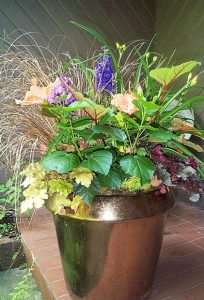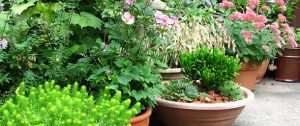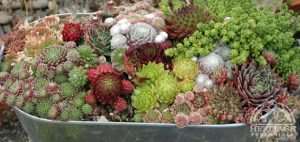Perennial Gardening in Containers
Perennials 101, Perennials for Special Purposes
- Container Garden Considerations

From patios and balconies to decks and porches, container gardens can add colour and interest to any area around your home… and you don’t even need a garden. There is a lot to consider in planting and maintaining container gardens, but these tips should provide enough information to make your first attempt a success.
Annuals make excellent long-flowering container specimens, however, perennials have one major advantage: although they do cost more initially, they can be placed out into your borders at the end of the season, gracing your garden for many years to come. Annuals, of course, require yearly replacement.
As more gardeners experiment with overwintering tubs and other containers with perennials in them, new information is becoming available on which plants will survive with minimal winter care, and which methods give the best results.
- Choosing a Container
Garden centers now carry a huge range of containers, so it is easy to select an attractive pot that fits your budget. Any container you use should have holes in the bottom to drain water. Some pots may not come equipped with drainage holes, but it is usually easy to drill some into the bottom with an electric drill and a concrete bit. On balconies or decks, large saucers might be useful to catch unwanted drips at watering time, but containers should not rest in standing water for long since the roots may begin to rot. Try partly filling the saucer with gravel and resting your container on top.
 If you plan to try overwintering perennials in your pots, avoid clay (also called terra cotta) pots, since these can easily crack and break from the action of water expanding in the soil when it freezes. Gardeners in very mild winter regions have less of a problem with this.
If you plan to try overwintering perennials in your pots, avoid clay (also called terra cotta) pots, since these can easily crack and break from the action of water expanding in the soil when it freezes. Gardeners in very mild winter regions have less of a problem with this.
The size of the pot makes a big difference to overwintering success. In Zones 1 through 7, pots should generally be at least 12 inches in diameter, and ideally over 16 inches. Those half whiskey barrels are an ideal size, but other large pots made of molded plastic (there are some GREAT plastic pots on the market now!), molded foam, concrete, wood or any other frost-proof material are worth considering. A depth of at least 12 inches is advised.
- Soil
The planting mix must be able to hold water and nutrients, yet drain well. Plain old garden soil is just too poorly drained for using as is, and most commercial potting soils are too light. A recommended blend is 75% soil-less potting mix and 25% weed-free, loamy topsoil. In some regions triple mix is available, which has equal parts of coarse sand, soil and either sphagnum peat or compost. Many gardeners have reported excellent results using triple mix in pots, right out of the bag. - Fertilizer
Whatever your choice of soil, those that contain only a small portion of actual garden soil will require you to provide the plants with additional fertilizer. Various slow-release products (Osmocote is a common brand) really cut down on extra work, but soluble liquid fertilizers (such as Miracle-gro) are also popular. Whatever the choice, follow the label instructions carefully as to the correct rate.  Selecting plants
Selecting plants
By including perennials in your container displays, it throws the windows wide open to experimentation with endless flower and foliage color, texture, blooming times, perhaps even winter interest. Including annuals in the “mix” is still wise, since few perennials will give you the same sort of all-season color that annuals should.
Starting with three basic plants is a good way to begin.
- First choose a flowering plant for long-season color… perhaps an annual or a perennial such as Moonbeam Coreopsis, or Scabiosa ‘Butterfly Blue’.
- Next, select a plant with attractive foliage as an accent, such as a Hosta, or something with silver, burgundy, gold or variegated foliage.
- Then choose another plant with a different foliage texture from the first two, but perhaps with either a complimentary (i.e. similar and blending well) or a contrasting (i.e. shockingly the opposite) flower color.
- Finally, choose a selection or filler plants. These could be several trailing plants to spill over the sides, or perhaps something with a delicate, airy sort of habit.
Since containers are meant to be focal points in the garden, this is a unique opportunity to be daring, and to use colors you might not ordinarily choose.
Our online Perennial Search Encyclopedia allows you to pull a list of perennials that are especially suitable for container gardening. Just search by Containers on the Attributes menu.
- Planting
Most container gardens look best when they are packed with plants, with little or no soil visible. Much closer spacing is usually used in pots than when the same plants are grown directly in the garden. It is difficult to generalize on this, since each plant grows differently, but aim for your container to look attractive immediately after planting, or with just enough extra space left for plants to fill in within a few weeks.
In contrast, alpine troughs (or other containers featuring rock garden plants) look best if the little mounding plants are placed with an inch or two of space in between. Try mulching the soil with a half inch of washed pea gravel, sand or small stones to give a finished look, and to prevent weeds or moss from flourishing.
- Watering and Maintaining
Plants in containers don’t have very much soil from which to draw water, so they require regular watering. To determine when to water, just stick your finger into the soil: if it feels dry, it IS dry. Always water thoroughly, until water runs out of the drain holes. Water may run right through very dry soil without actually wetting it. If you aren’t sure, pick up or slightly tip the container to test that it has become much heavier with water. If not, the container might need to be watered repeatedly, or even allowed to soak for a couple of hours in a tub of water.
Terra cotta (clay) and paper fiber containers dry out particularly quickly because they wick water out of the soil through the sides of the pot. Count on more frequent monitoring for these pots.
As a guideline, large containers in the sun require thorough watering twice a week, minimum. Containers planted with succulents or drought-tolerant alpines require less frequent watering and can endure several days without the hose.
Maintenance consists of removing faded flowers to promote re-bloom and pruning back leggy plants to keep them looking tidy and to encourage fresh, compact growth. Weeds should be removed as soon as they are noticed.
- Winter Care
Gardeners in many different zones are reporting great success with wintering plants by simply taking the tubs or pots into an unheated garden shed or garage in late fall. Pots should be watered one last time, placed inside and then ignored until early spring. At that time, bring the pots outdoors, remove any dead plant tops from the previous season, then water thoroughly. If you use slow-release fertilizer, spring is also the time to add some to the soil surface and gently work it into the top couple of inches, between the plant clumps.
Successful wintering has much to do with your initial selection of plants. If you live in Zone 5, best results will be with perennials rated hardy in Zones 1 through 3, for instance. Growing plants rated two full zones colder than your region is wise, since the roots of plants in containers may experience more extremes of cold than those growing in your garden.
Some gardeners are also report good wintering results by simply leaving pots in a sheltered, shady spot outdoors… say, on the north side of the house. Bear in mind that winter winds may dry the soil out, so watering might be required during winter thaws. Use whatever extra snow is available, piling it over the pots for added insulation from the cold.
- Container Ideas
Boot Gardens
There is plenty of room for flights of fancy with container gardening. How about growing drought-resistant Hens and Chicks (Sempervivum) in old work boots filled with sandy soil? You could pose them permanently plodding up your steps!
Winter Gardens
There are numerous perennials, vines and shrubs which, in milder regions, remain attractive all winter. Consider planting Winter Heath (Erica carnea) with Bergenia, pansies, flowering kale and English Ivy (Hedera helix).
The Blues
How about all-blue flowers and foliage? Try Serbian bellflower (Campanula poscharskyana) with blue fescue (Festuca glauca), English Lavender, Salvia ‘Blue Queen’ and dwarf Delphinium ‘Blue Mirror’.
Arid Gardens
Many varieties of succulent, drought-resistant perennials are available for this. A selection of colorful Sedums, Hens-and-Chicks, and Donkey-tail Spurge (Euphorbia myrsinites) can transform a large clay or concrete container into a spectacle of intriguing year-round color. Even better, succulent plants are generally tolerant of irregular watering.
Alpine Troughs
There are so many kinds of creeping and cushion-forming alpines and rock garden plants suitable for container gardens. Concrete troughs are an excellent way to display these; you can build troughs yourself or purchase them all ready to be planted up.